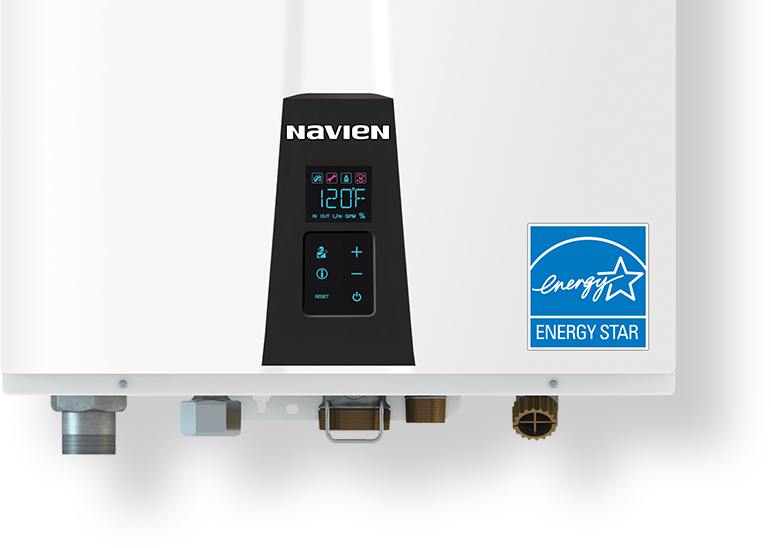One of the biggest benefits of tankless water heating is that you have hot water on-demand for as long as you like. You never need to worry about running out as long as you have water and power going into your home. However, without a backup plan, hot water tankless units can go cold if they’re experiencing malfunctions. Let’s go over a few reasons why.
Firstly, we need to address the infamous cold water sandwich you hear about tankless units. This is when you have a hit of hot water followed by cold water, eventually warming back up again. When you’re washing dishes this is no big deal, but in a shower the feeling can be pretty jarring. Most of the time it isn’t a reason for concern: it happens when a bit of hot water is left in the piping from the last time hot water was accessed. When that small amount runs out, next is cold water because the unit’s heat exchanger is yet to warm up. A few seconds later you’ll get hot water when the exchanger is up to temp.
Many tankless water heater manufacturers work around this problem with buffer tanks (a tiny reserve tank of insulated hot water) or recirculating systems that reuse warm water in your unit and in your pipes. Noticing a cold water sandwich can be an indicator that your water heater is slightly malfunctioning but most of the time you’ll experience it, it has to do with lag time between you opening a faucet and the heat exchanger getting to temp.
Malfunctioning flow sensors
-
- Tankless systems rely heavily on flow sensors to ensure water pressure in the unit remains at a safe level and that the rate of water entering and exiting the unit is controlled. If a flow sensor is not working optimally, it may not notice cold water entering the system and lowering the heat of outgoing water. Furthermore, if the sensor incorrectly believes not enough water is entering the water heater, it will shut off in the assumption that there is a blockage down the pipe, depriving you of hot water as a safety mechanism.
Crossover problems
-
- Crossover is a plumbing term used to describe the mixing of hot and cold water. In tankless systems, the unit is connected to the main water supply and return lines. It relies on mixing valves, pressure balancing valves, and smoothly-operating house-wide plumbing in order to accurately modulate how water is heated and cooled in your home. If the piping is damaged, the unit was incorrectly installed, the mixing valves are not operating optimally, or your faucet is malfunctioning, excess cold water could be entering your hot water and making it lukewarm or cold.
- Determining if your lack of hot water is a result of plumbing crossover is simple enough: shut off the water main’s connection to your water heater and open any hot water tap. Run it for 5 to 10 minutes to flush out any water left in the piping – if you’re still getting water through the tap after this time, you have a crossover issue. You can inspect the mixing valves, the water mains (and connections), and the faucets to see if any of them are damaged. If the issues persist, call a water heater technician.
Gas line sizing issues
-
- In a gas-powered tankless unit, installing properly-sized gas lines is critical to ensuring your water heater operates optimally. Most gas-powered units require homeowners to extend the size of their gas supplies when installing a tankless system in your home to ensure the water heater has access to enough fuel. An undersized line won’t allow the burners to fully ignite and will not be able to heat the cold water to a desired level.
- The simplest way to fix this is to install properly-sized gas lines. For most tankless units these lines need to be 1” in diameter but speak with your water heater technician and consult the model’s specifications to make sure. If you’re running the right size line but your lack of hot water is still as a result of your gas intake, it is possible that your home’s gas meter has a limiter that will need to be upgraded.
Low water pressure
-
- Tankless units are sensitive to water pressure and flow rates within your home’s plumbing system. If a build-up of lime scale, a blockage in your piping, or any other factors that affect water pressure occur, your water heater’s flow sensor can prevent the unit from turning on and heating. There is a minimum flow rate that is needed in order to ensure the heat exchanger operates optimally: too little flow and the unit’s internal computer assumes there’s a blockage or pressure malfunction and won’t shut on until that flow rate is back to normal. Different models with different capabilities have varying minimum (and maximum) flow rates to turn on. Speak with your hot water technician and consult the manufacturers to ensure your water pressure is compatible with your water heater.
Clogged water filter
-
- Tankless water heaters use a cold water inlet filter to catch any particulates in the cold water before it enters the unit and is exposed to the heat exchanger. This water filter is critical to minimizing sediments in your water that eventually result in the solidification of calcium carbonate and limescale in your unit and pipes. It needs to be regularly de-scaled in order to keep your unit running optimally – if it gets plugged up, the flow rate of incoming water can change abruptly, toggling the water heater between on and off settings. The result is the oft-feared cold water sandwich. Removing, cleaning, and/or replacing the cold water inlet filter is a regular part of maintaining and servicing your tankless water heater.
Calcification and limescale on your heat exchanger or in your pipes
-
- After continuous exposure to hard water, your water heater will eventually collect sediments that can solidify and form anywhere water passes through. These chunks of hardened minerals in your pipes will affect the way water flows through your plumbing system, causing fluctuations in flow rates (and we all know how sensitive tankless systems are to flow rate).
- Furthermore, if limescale builds up around the unit’s heat exchanger, it can effectively insulate the heating element of the unit and prevent it from heating water effectively. Mineral buildup is the most common reason tankless water heater temperatures can fluctuate, so de-scaling is an important part of maintenance.
Capacity and demand problems
-
- The last potential reason for cold water in your tankless system is because your water heater is not built for the demand you’re putting it through. If the unit is too small and multiple taps around the house are opened, the resulting fluctuation in water pressure and large increase in cold water entering the unit could cause the water heater to operate inefficiently, unable to heat to match the demand.
- When you are selecting a new tankless water heater, having an accurate calculation of your regular hot water demand and what it spikes to at peak hours (in gallons-per-minute/GPM) will allow you to make the right purchase for your home and lifestyle. For individuals with big households and large demand for hot water, it can be worth investing in a second unit that will shoulder some of the load.



